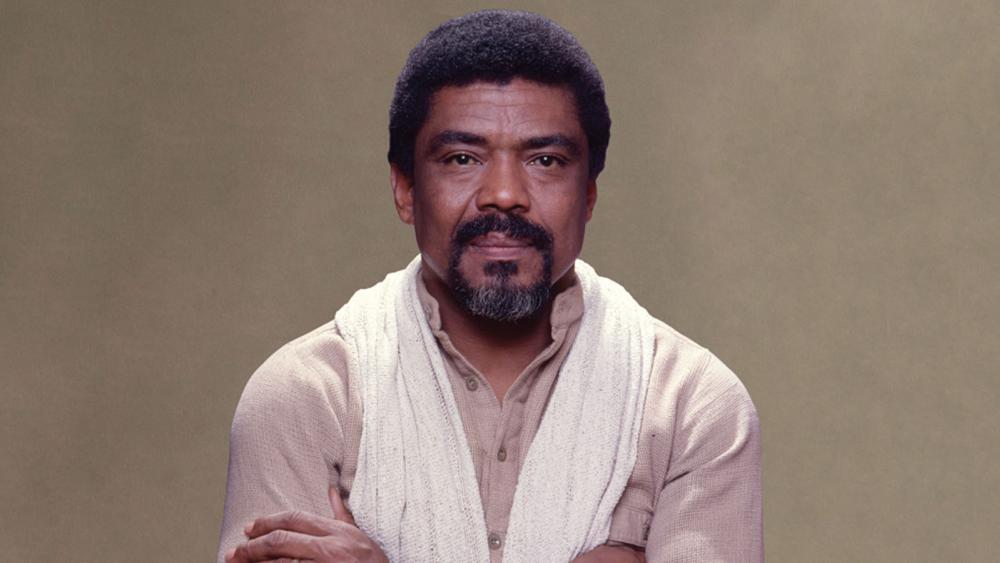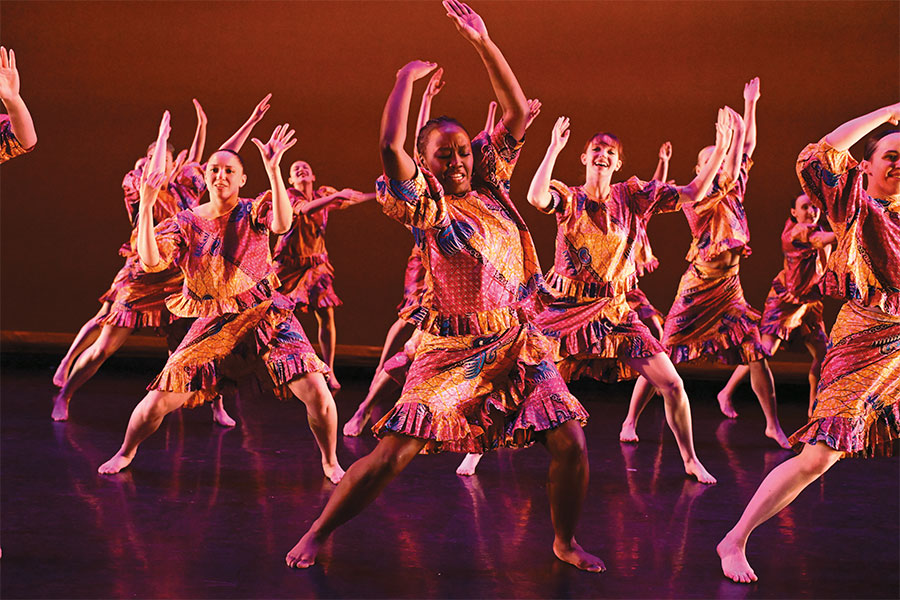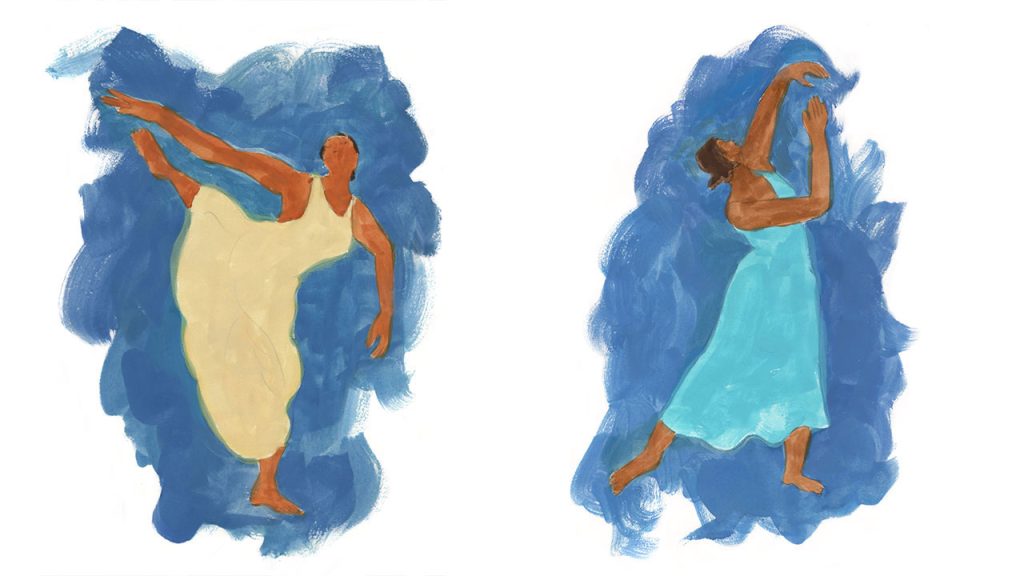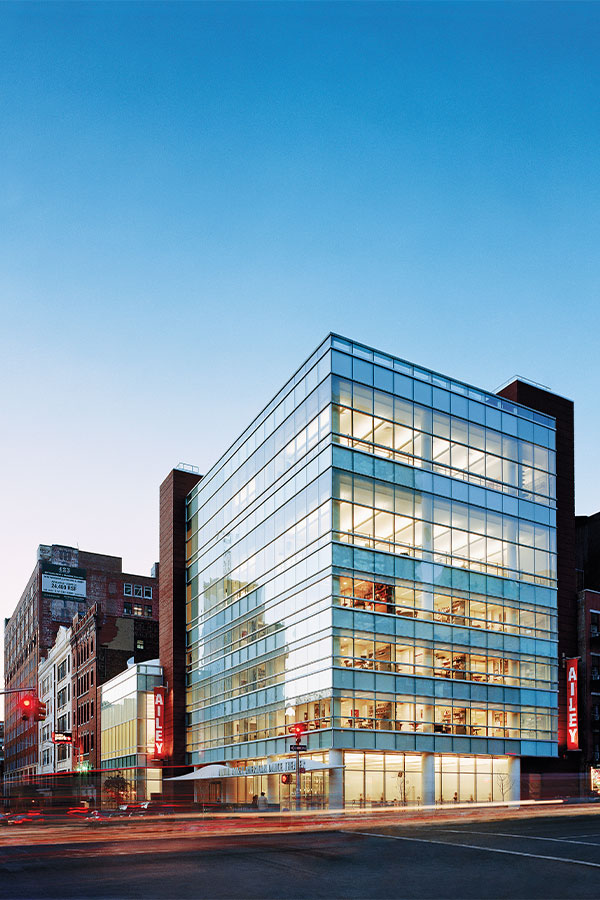The partnership between Fordham and the Ailey School has grown into one of the preeminent BFA dance programs in the country. Its graduates—inspired by Alvin Ailey’s trailblazing, humanist vision—have used their holistic education to make an impact in the arts and beyond.
They step in unison, arms pumping down in front of them like pistons. They kick a leg out and, exactly on the six-count, spin 90 degrees to repeat their march. Then again, another 90 degrees, before launching off the ground for a spin. Floor-to-ceiling windows frame their movements with views of West 55th Street and Ninth Avenue, where cars, buses, and pedestrians are engaged in their own choreography, sometimes slowing to take in the studio scene. There’s no music inside—only footsteps, hard breathing, and shouted notes of correction and encouragement.

The dancers are seniors in the Ailey/Fordham BFA in Dance program, which is celebrating its 25th year. They’re in the Joan Weill Center for Dance in Manhattan—home of the Ailey School, five blocks from Fordham’s Lincoln Center campus—rehearsing teacher and choreographer Earl Mosley’s Running Spirits (Revival and Restaging) for the program’s annual benefit concert in mid-April.
In another ground-floor studio about a month before the concert, first-year students take West African Dance with Imani Faye. As a drummer slaps out a beat on a djembe, Faye guides the students through their own performance piece, Den-Kouly (Celebration), with its traditional Tiriba and Mané dance styles from Guinea.
As the students work to nail the choreography, they’re also grappling with bigger, more complex movements. For the first-years, it’s the culmination of nine months spent testing themselves, body and mind. Are they able to balance a rigorous dance training program and a rigorous academic curriculum? And for the seniors, it’s a time of final exams and frequent auditions. Are they ready to secure their place in the professional dance world?
Carrying on the Legacy of an American Dance Pioneer
The idea for a best-of-both worlds BFA program—top dance training and top academics in New York City—came several years before the first class arrived in the fall of 1998. Edward Bristow, then dean of Fordham College at Lincoln Center, struck up a conversation with Ailey School director Denise Jefferson in line at the West 60th Street post office. He believed Fordham could do more to make its presence felt “at the center of the arts world,” and Jefferson was interested in building a college degree program for Ailey dancers. “We knew that given our strengths, we could pull off something special,” he recalled.
Today, the program is led by Melanie Person, co-director of the Ailey School, and Andrew Clark, a Fordham professor of French and comparative literature who had served as an advisor to many BFA students before succeeding Bristow as co-director in 2023. Through their leadership, the Ailey/Fordham students are staying true to the vision set forth by Bristow and Jefferson, who died in 2010. They’re also upholding the legacy of Alvin Ailey himself, a towering figure in modern dance.

Ailey founded his namesake dance company in 1958, when he was 27 years old. His story and the story of the company he founded are inextricable from the histories of Black art in America and the Civil Rights Movement. At a time when Black dancers found it next to impossible to make a career through their craft, Ailey created a home for them. Since its inception, the Alvin Ailey American Dance Theater has become not only one of the most successful Black-founded arts institutions in the United States but also one of the premier modern dance companies in the world, described in a 2008 congressional resolution as “a vital American cultural ambassador to the world.”
Texas native Antuan Byers, FCLC ’17, is one of many BFA students and alumni who say they were drawn to the program after seeing the company perform during their formative years. “I attended my first Alvin Ailey performance my senior year of high school, in that moment of still being on the fence about where I wanted to go to school,” said Byers, who was a member of Ailey II, the company’s junior ensemble, and now dances most frequently with the Metropolitan Opera. “After seeing the Ailey company, it all became clear.”
For many Black students in the BFA program, Alvin Ailey’s legacy serves both as an inspiration and a reminder of the challenges that dancers of color have faced. It’s hard to miss that legacy when you’re inside the Weill Center, with its walls lined with photos and ephemera spanning seven decades.
“Every day I try to use the weight of his legacy to further encourage me and push me in my craft,” said Naia Neal, a rising senior from Santa Cruz, California, who earned the program’s Denise Jefferson Memorial Scholarship and is pursuing a minor in math. “Alvin Ailey loved to dance, but he also understood that dance should be for everyone. He made it known that everybody deserved to be there.”
The dance landscape looks a good deal different today than it did in 1958. Black choreographers like Kyle Abraham and Camille Brown have had their work performed by New York City Ballet and the Metropolitan Opera; Black dancers are members of most major companies in the United States; and Black administrators are artistic directors at places like Pacific Northwest Ballet and Philadanco. But on many stages, Black dancers are still underrepresented, and for many students of color, a place like the Ailey School still functions as a home where they can chart a professional path.
“Something about being here has opened up a completely different relationship with me and what I add to different spaces and what it means to be a Black dancer,” said Carley Brooks, a rising Ailey/Fordham senior from Chicago pursuing a minor in communication and media studies. “The [Ailey] building allows me to feel so comfortable and confident in my body and what I have to present.”
Developing the Whole Dancer
If one thing defines the Ailey/Fordham experience, it’s the need to find balance within a hectic schedule. All students take ballet every semester, a way to keep them grounded in classical technique, and in their first year, they also take West African Dance and begin training in either the Horton technique or Graham-based modern dance. They also have foundational classes like Improvisation, Body Conditioning, and Anatomy and Kinesiology. And they take two Fordham core curriculum classes each semester, including first-year staples like English Composition and Rhetoric and Faith and Critical Reasoning.
In their sophomore year, students decide if they want to pursue a second major or a minor. It’s a decision they don’t make lightly, as it comes with extra coursework, but for many students, it’s a way to help them plan for careers beyond performing—and to infuse their dance practice with outside influences. That year, they also take Composition, and for many of them, it’s the first time they formally work on their own choreography—a complex process, with varying notation systems and a good deal of trial and error.
As juniors, the students continue to branch out intellectually. In the Ailey academic class Black Traditions in Modern Dance, they engage with history while also thinking about the artistic choices involved in a performance. Meanwhile, in Fordham classrooms, many begin fulfilling the requirements for a second major.
They also have a chance to become mentors to their first-year counterparts. Jaron Givens, a rising senior originally from Prince George’s County, Maryland, who is majoring in both dance and environmental studies, has relished the opportunity to pay forward the mentorship he received during his first year. He took part in the Ailey Students Ailey Professionals mentorship program, which pairs students with Ailey company members. Givens met with Courtney Celeste Spears, FCLC ’16, who he said “facilitated a space where I was able to be vulnerable … and showed me how much Ailey cared.”
The Ailey School has been working with Minding the Gap, an organization that offers mental health services to dancers. The hope is to give students as much access to mental health support as they have to things like on-site physical therapists at the Weill Center. On the Fordham side, faculty describe a similar focus on students’ well-being. “I try to … get a sense of what their concerns are, what they’re enjoying, and what they’re struggling with,” Clark said. “That’s where you really get a sense of the whole person and you have the ability to help out.”
There’s also a natural level of camaraderie that comes from spending so much time with fellow BFA students, both in dance classes and often in academic ones. “For us, it’s not a competition,” said Sarah Hladky, a rising junior who is majoring in English as well as dance. “Ailey very much emphasizes the fact that there is a space for everyone. And so even if people come in feeling like they need to prove themselves, at the end of the day you leave being like, ‘No, I am the dancer that I am, and you are the dancer that you are. And we can coexist and really make a great environment for each other.’”
While a sense of community is integral to the Ailey/Fordham experience, students are well aware that they’re training for a highly competitive profession. The postgrad goal for many of them is to join a dance company full time—with the Alvin Ailey American Dance Theater and Ailey II often at the top of the list. Many alumni earn a spot in those companies and others such as Dance Theatre of Harlem, the Martha Graham Dance Company, and the Radio City Rockettes. Others regularly appear on Broadway stages and in film and TV productions. But a benefit of their Fordham studies is that they graduate prepared for any number of career paths.
“My education at Fordham was instrumental in my formation as an artist and businesswoman, providing me with a depth of knowledge, curiosity, and appreciation for many subjects that gave me a foundation to build on,” said Katherine Horrigan, a 2002 graduate who went on to dance with Ailey II, Elisa Monte Dance Company, and a number of other companies around the world before launching a dance academy in Virginia.

Spears encourages Ailey/Fordham students to “build your academic resume as much as you build your dance resume.” She said the program expanded her ideas of what she could do as an artist and a leader. She began dancing with Ailey II in 2015, her senior year, and moved up to the Alvin Ailey American Dance Theater before deciding in 2023 to focus full time on ArtSea, her arts organization in the Bahamas. “I think if you focus on having viable options and stretching how many different places you are able to impact, you then have the mountaintop,” she said.
[RELATED STORY: “Bridging Art and Entrepreneurship”]
For Samar Haddad King, a 2005 Ailey/Fordham graduate, a composition class with Kazuko Hirabayashi was so transformative that she decided to focus on choreography. For her class’s senior concert, she premiered an original piece, and the following year, with her BFA classmate Zoe Rabinowitz, she co-founded the company Yaa Samar! Dance Theatre, based in both New York City and the West Bank. Nearly 20 years later, they have brought their work to 17 countries around the world.
Rabinowitz has carved out her own unique path since graduating in 2005. While she still dances in Yaa Samar! and elsewhere, her role as the company’s executive director builds upon several post-college jobs in arts administration, and she has also taught yoga and Pilates throughout her career. Acknowledging the finite amount of time most people can dance professionally, she said it’s important for young dancers not only to develop academic interests but also to take an expansive view of the dance world.
“Finding the things that you enjoy doing—the passions and the strengths that you have cultivated inside and outside of your dance training—and finding ways that you can do those things to implement jobs and create sources of income is going to be critical for most people,” Rabinowitz said, adding that dancers are known as great team members across industries. “Recognize that you come with a really strong skill set and work ethic, and that you have the capacity to do a lot of things.”
Person, the Ailey School co-director, echoed that sentiment. “The skills that they acquire as dancers are going to be transferable in any aspect of their lives. With the Fordham degree and their strong academics, they’re well situated to exist in the world.”
Whatever part of the dance or professional world they end up in, Ailey/Fordham alumni often maintain the close bonds they shared as undergraduates, and now there’s an additional way for them to stay connected. Ahead of the program’s 25th anniversary, Byers and Maya Addie, a 2021 graduate who is a member of the Radio City Rockettes, learned about Fordham’s affinity chapters—alumni communities formed around shared interests, past student involvement, or professional goals. They decided to start one for Ailey/Fordham BFA graduates.
“It’s a personal goal of ours to bring together our alumni because we have such a wealth of knowledge in that group,” Byers said. “In dance but also in our incredible business owners, or folks working in politics, folks working in finance, people teaching, people with kids. We see this 25th anniversary as an opportunity for us to really build an alumni program with all that excitement and energy.”
A Performance to Mark Endings and New Beginnings
On the evening of the spring benefit concert, after a cocktail reception on the sixth floor of the Weill Center, family, friends, and fans of the BFA program made their way to the Ailey Citigroup Theater on the building’s lower level. Following a brief video highlighting the history and mission of the program, Neal kicked off the evening’s performances with The Serpent, a solo piece choreographed by Jonathan Lee. To the pulsing beat of Rihanna’s “Where Have You Been,” she gave a high-energy performance that incorporated styles ranging from modern and hip-hop to voguing. Unlike the more restrained audience traditions one might see up the street at Lincoln Center for the Performing Arts, the audience cheered throughout the piece.
That energy level, both onstage and in the crowd, continued with the first-year students’ West African piece, Den-Kouly (Celebration), featuring vibrant costumes and jubilant movement. The sophomores performed an excerpt from the more ballet-centric For They Are Rivers, choreographed by Becky Brown, and the juniors danced an excerpt from Darshan Singh Bhuller’s athletic, abstract Mapping. Three Ailey/Fordham alumni—Mikaela Brandon, FCLC ’19; Naya Hutchinson, FCLC ’21; and Shaina McGregor, FCLC ’18—came back to dance alongside Neal in Four Women, choreographed by senior student Baili Goer.

The final performance of the night, appropriately, belonged to the seniors. Since that March rehearsal of Running Spirits, Mosley had revealed to the students the meaning behind the piece, which he first choreographed for a group of preteen boys at a summer program in Connecticut in the late 1990s. At the time, he explained, he was dealing with a group of rambunctious kids who loved to run around—and whose parents thought of them as “little angels.” It made him imagine a scene in which a group of angels, who get around via running instead of flying, are all gathering in the morning to plan out their work agenda for the day.
“When I tell dancers that’s what it’s about,” Mosley said, “they always laugh because they’re like, ‘Really? That’s all? So we’re just literally getting ready to go to work?’ I’m like, ‘Yeah, you’re just getting ready to go to work.’”
It’s a playful piece, but the version Mosley created for these graduating dancers is one that requires strong technique and collaboration, and features impressive jumps, lifts, and, as the title suggests, speed. There was a sense of mischief onstage, an almost conspiratorial glee to the movements. That tone felt appropriate considering all the students had been through in their nearly four years together, from beginning the program at the height of the COVID-19 pandemic to trying to wrap up their final semesters while planning for the future.
“This past year has probably been the most challenging in terms of juggling my schedule,” said Meredith Brown, a dance and economics double major from Asheville, North Carolina. “Because I’m also auditioning and making sure that I’m taking care of myself and enjoying the city and taking advantage of all these wonderful things.”

Brown and her fellow 2024 graduates are in a better place to manage those competing demands than they were four years ago—not only more experienced but also more confident.
“When I think about my first year, there was a lot of imposter syndrome,” said Abby Nguyen, a 2024 grad from the Bay Area who double majored in dance and psychology. “There was this constant feeling like I needed to prove myself, that I needed to prove that I was good enough to be here. But ultimately, you are here, and you are good enough to be here—or else you wouldn’t be in the building.”
The dancers’ growth has also been visible to Person, who recalled the challenges the Class of 2024 faced starting college during the pandemic. “I was watching them rehearse the other day, and I think they really came together as a class,” she said. “I think they relied on each other to push through this, honestly. … I think it gave them this inner strength that they might not have even recognized that they have.”
And while challenges certainly lie ahead—auditions, demanding dance jobs, the threat of injuries, and more—Mosley believes this group of graduates is ready to face them.
“They give me the energy like, ‘Oh, I know I’m going to do something,’” he said. “‘There’s
no doubt, I’m going to do something.’ This group as a whole is all about it.”



